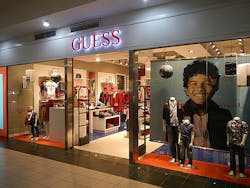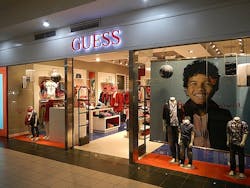Swiss fashion shops install the company's wireless radio beacons, but not its lights. Is this how the lighting industry can finally crack the location-based services market?
As vendors struggle to sell lighting-based indoor-positioning systems, Osram has come up with a different way to make progress: Sometimes, instead of selling lighting, settle for providing the wireless radio chips that transmit signals such as Bluetooth which are crucial to the technology's operation.
That's what Osram did in Switzerland, where it furnished Bluetooth chipsets to a fashion retailer that tacked them onto existing lights at 23 stores throughout the country, including Guess and Marc O'Polo shops. The only purpose the lights serve in the indoor-positioning job is related to power supply: The Bluetooth transmitter runs off the same electricity conduit as the lights, thus avoiding troublesome batteries and their annoying tendency to drain.
In an indication of just how important the sale of IT products can be to the future of the lighting industry, Osram told LEDs Magazine that it makes the Bluetooth transmitters itself, rather than stocking them through a private-label partnership with an IT company. They carry the Osram Einstone brand name, and are part of Osram's broader Einstone indoor-positioning scheme, which it launched a year ago. Osram refers to the transmitters as “beacons,” a term long associated with signaling via fire and light but which is increasingly common for devices that send out radiowaves such as Bluetooth, Wi-Fi, and radar.
Indoor-positioning systems at Guess, Marc O'Polo, and Gallery shops in Switzerland have induced customers to spend over 10% more than they would have, according to Osram. (Source: Ramon F. Velasquez via Wikimedia Commons.)
While Osram also markets Einstone LED luminaires that contain built-in Bluetooth transmitters, that is not what it has done with Zurich-based Bollag-Guggenheim Fashion Group AG. Bollag-Guggenheim started installing the Einstone Bluetooth chips — but not lights — last September at Guess and Marc O'Polo shops it runs in Switzerland, as well as its own Gallery chain. Gallery offers different fashion brands under one roof.
“In this case, we used an Einstone track adapter to integrate the Einstone beacons into the lighting infrastructure of the respective stores,” an Osram spokesperson told LEDs. “The advantage of this procedure was that retailers could simply retrofit Einstone in the existing lighting infrastructure — without any need to change the whole lighting.”
Referring to the electricity link, she added, "The big advantage of Osram Einstone beacons is that they are constantly powered.” By comparison, battery-powered beacons can lose their charge, undermining operations and often creating difficult maintenance and replacement tasks.
Sparking sales
Bollag-Guggenheim uses the technology to engage on-premise customers and coax them into spending more money. Einstone transmits signals to users of the retailers' Gallery mobile phone app, welcoming shoppers to stores and offering them tailored promotions and information based on individual buying habits, preferences, and loyalty schemes.
Einstone appears to be paying dividends, as shoppers have spent over 10% more than they otherwise would have at the Swiss shops, according to Osram.
The system knows the customer's purchasing history and proclivities through loyalty schemes connected to Einstone using software from beaconsmind, a new Osram Einstone partner which integrates Bollag-Guggenheim's point of sale software (POS) and customer relations management (CRM) programs.
“Customers entering the store now benefit from personalized welcome messages and offers,” Osram says on its website. “In-store purchase behavior is captured at the point of sale and made accessible to Bollag-Guggenheim via the beaconsmind Suite dashboard.”
Indoor positioning, also known as location-based services, is an important technology that LED lighting vendors hope to exploit now that they can no longer rely on replacement bulb sales as they did in the bygone era of incandescent lighting, when lamps lasted a year or two, compared to the purported decades for LEDs. They are targeting the retail industry as a major indoor-positioning market and are also aiming at other sectors such as office buildings.
Earlier this week, Osram rival Philips Lighting cited a forecast from ABI Research that the indoor-positioning market will triple by 2020 to over 1 million installations.
But one challenge the lighting industry faces is that the IT industry could dominate the market, which does not really require lighting technology.
One bonus that lighting has it that it provides a ready-made ubiquitous infrastructure. Some lighting vendors, Philips among them, have also advocated using lightwaves from LED light sources rather than Bluetooth radio as a means to transmit to phones. That technology is called visible light communication (VLC).
Sluggish start
At any rate, the indoor-positioning concept has been slow to take off for lighting vendors. The largest known lighting-based retail trial, by US giant Target, was covering about 100 stores at last count over a year ago. Target has never revealed the supplier, although LED specialist Acuity Brands could be in the mix given that it supplies some level of smart LED lighting to Target stores. Acuity claims to have Internet of Things (IoT) lighting in nearly 40 million ft2 of retail space, although it will not reveal where nor will it provide details on what exactly the IoT lighting does.
There have been few announcements of indoor-positioning installations, even though the lighting industry has been talking up the possibility for at least four years. Some industry watchers believe there could be some updates next week at the EuroShop retail trade fair in Dusseldorf.
Osram has refrained from loudly publicizing the Bollag-Guggenheim deployment. News surfaced earlier this week when LEDs Magazine sister publication Lux wrote that one of the Bollag properties, Marc O'Polo, has successfully deployed Osram indoor positioning. Osram has not issued a press release, although it has posted a general background about the project on its website.
Osram rival GE was promoting indoor positioning as far back as 2013 but has yet to announce a single retail user. It has conducted five pilots according to its lighting and energy group, called Current, powered by GE.
Philips Lighting has announced only two small trials over the last couple of years — at a single Carrefour store in France and at a group of aswaaq stores in Dubai — and none for a year.
To help jump-start the business, Philips has just signed a raft of new partners from the IT industry including Microsoft to try to develop compelling uses.
Bluetooth versus VLC
Philips also revealed that it is now embracing Bluetooth radio chips as a means for sending signals to phones, while continuing to back VLC, the technology which embeds signals in the modulation of LED lightwaves. VLC would also guarantee that lighting companies, as much as IT companies, secure a solid share of the indoor-positioning pie.
Osram eschews VLC in favor of Bluetooth, a view shared by other lighting specialists such as startup Gooee. When Osram introduced Einstone last year, it pointed out that Bluetooth, as a radio technology, does not require line of sight the way VLC does and is thus less cumbersome for the end user. It also noted that VLC requires more luminaires than does Bluetooth.
VLC has the advantage of being more accurate than Bluetooth as a location tool. In cavernous stores, such as a Walmart or a Target, it can more reliably direct a shopper toward the beer or diapers, for example.
But pinpoint accuracy might not be so critical to many humans who are capable of finding their way around shelves and aisles.
In Switzerland, navigation does not seem to be an overly important feature for Bollag-Guggenheim, whose properties are comparatively smaller than a massive mass-merchandise outlet like a Target or Walmart.
Navigation aside, the main objective for any retailer’s indoor-positioning deployment would be to increase customer spending, which seems to be happening for Bollag-Guggenheim. Osram's webpage says the stores have so far “generated a lift in average basket value of more than ten percent,” and implies that shoppers have been cashing in Einstone-delivered coupons at a high rate.
The Osram spokesperson told LEDs Bollag-Guggenheim started out as a trial deployment but is now a full-fledged commercial installation. She declined to elaborate on cost and pricing, or how the parties might share data.
She also would not say what type of lighting the Bollag-Guggenheim stores use. But the lighting per se was not part and parcel of the indoor-positioning system.
The spokesperson said the sale of Einstone Bluetooth beacons, as at Bollag-Guggenheim, is just as much a part of Osram's indoor-positioning strategy as the sale of luminaires that contain embedded beacons, with the embedded product intended for new installations and the external beacons for retrofits to existing lighting.
“Both solutions are part of the Einstone product portfolio in order to provide customers with the greatest possible flexibility,” she said.
You could also say that Osram is hedging its bets in the indoor-positioning business, approaching it as both a lighting company in the case of fully-equipped luminaires, and as an IT company, in the case of beacons only.
It stands to reason that Osram would ultimately prefer to sell the luminaire version. But the two-pronged approach squares well the often-repeated insistence by CEO Olaf Berlien that Munich-based Osram is now a “technology company.” It's a sort of back-to-the future scenario for Osram, which not many years ago was part of a broader technology and industrial company, Siemens.
Either way — luminaire or beacon only — there is a business model in providing location services and in collecting, massaging, and repurposing all the data that goes along with it.
MARK HALPERis a contributing editor for LEDs Magazine, and an energy, technology, and business journalist ([email protected]).






